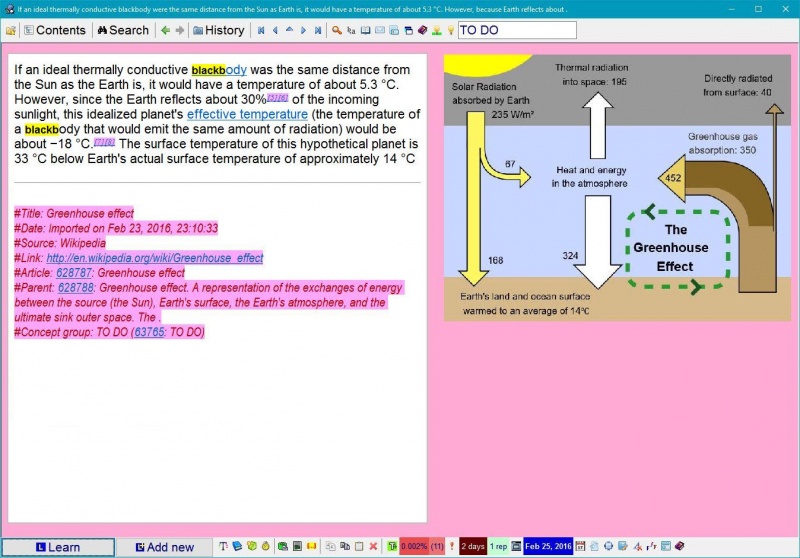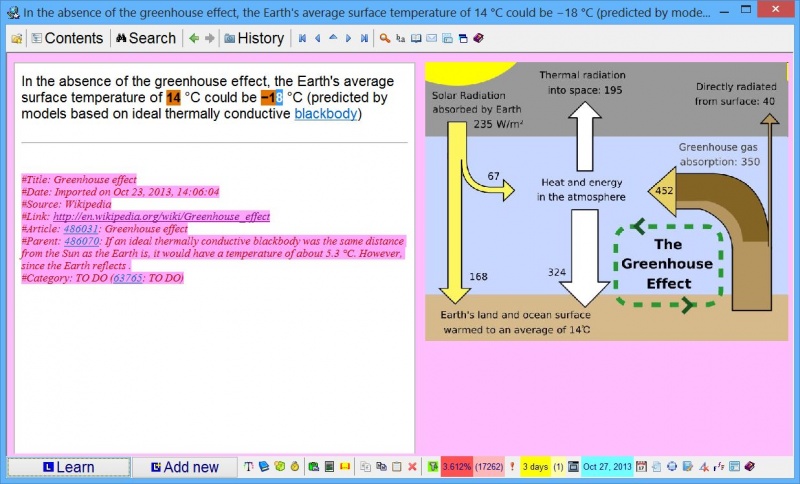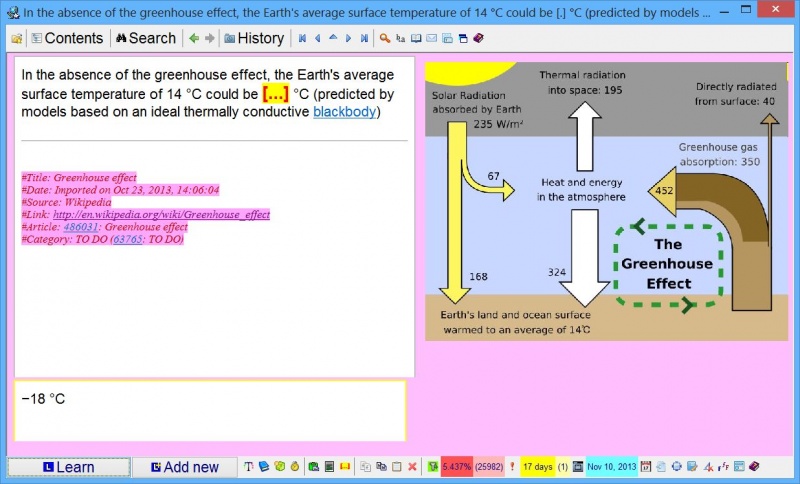Skill 3: Extracting fragments, questions and answers
Extracting texts
In the course of traditional reading, we often mark important paragraphs with a highlighter pen. In SuperMemo, those paragraphs can be extracted as separate mini-articles that will later be used to refresh your memory. Each extracted paragraph or section becomes a new element that will be subject to the same reading algorithm as the original article. Extract important fragments and single sentences with Extract ( [imagelink]). Use Alt+X, Extract on the learnbar, or Extract on the Read toolbar.
[imagelink]). Use Alt+X, Extract on the learnbar, or Extract on the Read toolbar.
Adding references
In incremental reading, you always need to quickly recover the context of a question or a piece of text. The easiest way to recover context quickly is via references. References propagate from element to element as you produce extracts and cloze deletions. With all child elements produced from a given text marked with references, you would never need to worry about losing the context of the question. When you import from the web, references are added automatically. You can also define them manually field by field. Exemplary references are shown in pink in the picture below. For details see: References.
Figure: Typical snapshot of incremental reading. While learning about the greenhouse effect, the student extracts the fragment saying that "In the absence of the greenhouse effect and an atmosphere, the Earth's average surface temperature of 14 °C (57 °F) could be as low as -18 °C (-0.4 °F), the black body temperature of the Earth.". The extracted fragment will inherit illustrations placed on the right, as well as article references. The student can move on to reading another article by pressing Enter. The picture on the right is stored locally in the image registry (on the user's hard disk) and can be reused to illustrate other articles or questions.
Cloze: Generating questions
SuperMemo will show you that extracting important fragments and reviewing them at later time will have an excellent impact on your ability to remember. However, it will also show that once the time between reviews increases beyond 200-300 days, reading and re-reading (passive review) will often result in insufficient recall. For this reason, sooner or later, you will need to convert your texts to specific questions. For that purpose you will use cloze deletion.
A cloze deletion is an item that uses an ellipsis ( [...] ) to replace a part of a sentence.
For example:
Question: The capital of Sierra Leone is [...]
Answer: Freetown
In incremental reading, cloze deletions are generated from topics that have a form of a sentence or a simple paragraph.
To create a cloze deletion do the following:
- make sure a topic contains a short sentence only (e.g. The capital of Sierra Leone is Freetown)
- select an important keyword in that sentence (e.g. Freetown)
- do one of the following:
- click the Cloze button (
 [imagelink]) on the Read toolbar, or
[imagelink]) on the Read toolbar, or
- press Alt+Z, or
- choose Reading : Remember cloze from the HTML component menu.
- click the Cloze button (
Remember cloze will convert a sentence into a specific question with an answer. By using cloze, you will move from passive review to active recall. You do not need to wait until a paragraph or a sentence becomes hard to recall in passive review. For your most important material, you can create cloze items immediately after finding a piece of information that you need to remember well.
The examples below show how to effectively use Remember cloze.
Figure: Two numbers from the extracted sentence are used as keywords for generating questions and answers (temperatures of 14 °C and -18 °C)
Figure: The sentence extracted during incremental reading (see the previous picture) is converted into a cloze deletion. (i.e. a question-answer pair forming the final product of incremental reading used in strengthening the memory of a given fact (here: hypothetical temperature on Earth devoid of atmosphere)). The picture from the original extract has been inherited (on the right). Pink texts at the bottom of the question are references generated automatically when importing an article from Wikipedia.
When you click Cloze, you will not see your newly generated cloze. Only the selected keyword will change the color. This will speed up your work. However, if you would like to immediately edit the newly created cloze deletion, choose the Back button ( [imagelink]) on the navigation bar or press Alt+Left arrow. This will make it possible to add context clues, shorten the text, improve the wording, etc.
[imagelink]) on the navigation bar or press Alt+Left arrow. This will make it possible to add context clues, shorten the text, improve the wording, etc.
Simplifying questions
While converting extracts into questions and answers, you should make sure your questions are simple, clear and carrying the relevant context. For example, if you have extracted the following fragment from your reading about the history of the Internet:
The Internet was started in 1969 under a contract let by the Advanced Research Projects Agency (ARPA) which connected four major computers at universities in the southwestern US (UCLA, Stanford Research Institute, UCSB, and the University of Utah)
you may discover that when review intervals become long enough, you may not actually be able to recall the name of the ARPA agency or even forget the year in which the Internet started. You can then select an important keyword, e.g. 1969, and use Remember cloze to produce the following question-answer pair:
Question: The Internet was started in [...] under a contract let by the Advanced Research Projects Agency (ARPA) which connected four major computers at universities in the southwestern US (UCLA, Stanford Research Institute, UCSB, and the University of Utah)
Answer: 1969
In the course of learning, you will need to polish the above item by manual editing it to a more compact and understandable form:
Question: The Internet was started in [...](year) under a contract let by the ARPA agency
Answer: 1969
Or better yet:
Question: The Internet was started in [...](year)
Answer: 1969
As for the precious information "lost" during the editing, it can (but does not have to) be learned independently with separate questions generated by Remember cloze.
The mini-editing of questions presented above added the following benefits to the newly created question-answer pair:
- clearer purpose of the question: the fact that the question is about the year in which the Internet began is emphasized by using the red-colored (year) hint.
- brevity: by removing superfluous information, you will not waste time on information that is not likely to be remembered (only actively recalled material will be remembered for years). You will answer the question and never focus on which universities were originally connected by the early Internet. If you believe this information is also important, you will use the original extract to produce more cloze items that will focus solely on the universities in question by naming them in the answer field (if you disagree, read: 20 rules of formulating knowledge).
- understandability: "the ARPA agency" phrase may defy grammar rules you have learned in primary school, but it is by far more understandable than just the ARPA. In SuperMemo, understandability is more important than stiff rules of grammar or spelling!
Summary
| status | not read | reprioritisations | ||
|---|---|---|---|---|
| last reprioritisation on | suggested re-reading day | |||
| started reading on | finished reading on |


